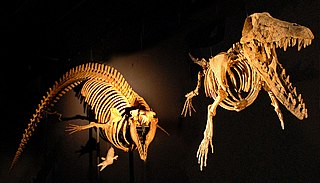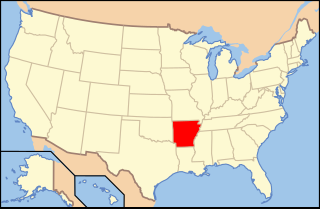
Paleontology, also spelled palaeontology or palæontology, is the scientific study of life that existed prior to, and sometimes including, the start of the Holocene epoch. It includes the study of fossils to classify organisms and study their interactions with each other and their environments. Paleontological observations have been documented as far back as the 5th century BC. The science became established in the 18th century as a result of Georges Cuvier's work on comparative anatomy, and developed rapidly in the 19th century. The term has been used since 1822 formed from Greek παλαιός, ὄν, and λόγος.
The Treatise on Invertebrate Paleontology published by the Geological Society of America and the University of Kansas Press, is a definitive multi-authored work of some 50 volumes, written by more than 300 paleontologists, and covering every phylum, class, order, family, and genus of fossil and extant invertebrate animals. The prehistoric invertebrates are described as to their taxonomy, morphology, paleoecology, stratigraphic and paleogeographic range. However, taxa with no fossil record whatsoever have just a very brief listing.

The Society of Vertebrate Paleontology (SVP) is a professional organization that was founded in the United States in 1940 to advance the science of vertebrate paleontology around the world.
Neontology is a part of biology that, in contrast to paleontology, deals with living organisms. It is the study of extant taxa : taxa with members still alive, as opposed to (all) being extinct. For example:

Archaeoceti, or Zeuglodontes in older literature, is a paraphyletic group of primitive cetaceans that lived from the Early Eocene to the late Oligocene. Representing the earliest cetacean radiation, they include the initial amphibious stages in cetacean evolution, thus are the ancestors of both modern cetacean suborders, Mysticeti and Odontoceti. This initial diversification occurred in the shallow waters that separated India and Asia 53 to 45 mya, resulting in some 30 species adapted to a fully oceanic life. Echolocation and filter-feeding evolved during a second radiation 36 to 35 mya.
Mesadactylus is an extinct genus of pterosaur from the Kimmeridgian-Tithonian-age Upper Jurassic Morrison Formation of Colorado, United States. The genus was named in 1989 by James Jensen and Kevin Padian. The type species is Mesadactylus ornithosphyos.
The Journal of Vertebrate Paleontology is a bimonthly peer-reviewed scientific journal that was established in 1980 by Jiri Zidek. It covers all aspects of vertebrate paleontology, including vertebrate origins, evolution, functional morphology, taxonomy, biostratigraphy, paleoecology, paleobiogeography, and paleoanthropology. The journal is published by Taylor & Francis on behalf of the Society of Vertebrate Paleontology. According to Journal Citation Reports, the journal has a 2017 impact factor of 2.190.
The Journal of Paleontology is a peer-reviewed scientific journal covering the field of paleontology. It is published by the Paleontological Society.

Berru is a commune in the Marne department in northeastern France.

Cernay-lès-Reims is a commune in the Marne department in north-eastern France.
Chelydrops is an extinct genus of Chelydridae from Miocene of North America. Only one species is described, Chelydrops stricta.
The Trigonoceratidae is a family of coiled nautiloid cephalopods that lived during the period from the Early Carboniferous (Mississippian) to the Early Permian.
Larachelus is an extinct genus of xinjiangchelyid turtle known from the Early Cretaceous of Spain.

Paleontology in Indiana refers to paleontological research occurring within or conducted by people from the U.S. state of Indiana. Indiana's fossil record stretches all the way back to the Precambrian, when the state was inhabited by microbes. More complex organisms came to inhabit the state during the early Paleozoic era. At that time the state was covered by a warm shallow sea that would come to be inhabited by creatures like brachiopods, bryozoans, cephalopods, crinoids, and trilobites. During the Silurian period the state was home to significant reef systems. Indiana became a more terrestrial environment during the Carboniferous, as an expansive river system formed richly vegetated deltas where amphibians lived. There is a gap in the local rock record from the Permian through the Mesozoic. Likewise, little is known about the early to middle Cenozoic era. During the Ice Age however, the state was subject to glacial activity, and home to creatures like short-faced bears, camels, mammoths, and mastodons. After humans came to inhabit the state, Native Americans interpreted the fossil proboscidean remains preserved near Devil's Lake as the bones of water monsters. After the advent of formal scientific investigation one paleontological survey determined that the state was home to nearly 150 different kinds of prehistoric plants.

Paleontology in Georgia refers to paleontological research occurring within or conducted by people from the U.S. state of Georgia. During the early part of the Paleozoic, Georgia was largely covered by seawater. Although no major Paleozoic discoveries have been uncovered in Georgia, the local fossil record documents a great diversity of ancient life in the state. Inhabitants of Georgia's early Paleozoic sea included corals, stromatolites, and trilobites. During the Carboniferous local sea levels dropped and a vast complex of richly vegetated delta formed in the state. These swampy deltas were home to early tetrapods which left behind footprints that would later fossilize. Little is known of Triassic Georgia and the Jurassic is absent altogether from the state's rock record. During the Cretaceous, however, southern Georgia was covered by a sea that was home to invertebrates and fishes. On land, the tree Araucaria grew, and dinosaurs inhabited the state. Southern Georgia remained submerged by shallow seawater into the ensuing Paleogene and Neogene periods of the Cenozoic era. These seas were home to small coral reefs and a variety of other marine invertebrates. By the Pleistocene the state was mostly dry land covered in forests and grasslands home to mammoths and giant ground sloths. Local coal mining activity has a history of serendipitous Carboniferous-aged fossil discoveries. Another major event in Georgian paleontology was a 1963 discovery of Pleistocene fossils in Bartow County. Shark teeth are the Georgia state fossil.

Paleontology in Arkansas refers to paleontological research occurring within or conducted by people from the U.S. state of Arkansas. The fossil record of Arkansas spans from the Ordovician to the Eocene. Nearly all of the state's fossils have come from ancient invertebrate life. During the early Paleozoic, much of Arkansas was covered by seawater. This sea would come to be home to creatures including Archimedes, brachiopods, and conodonts. This sea would begin its withdrawal during the Carboniferous, and by the Permian the entire state was dry land. Terrestrial conditions continued into the Triassic, but during the Jurassic, another sea encroached into the state's southern half. During the Cretaceous the state was still covered by seawater and home to marine invertebrates such as Belemnitella. On land the state was home to long necked sauropod dinosaurs, who left behind footprints and ostrich dinosaurs such as Arkansaurus.

Paleontology in Colorado refers to paleontological research occurring within or conducted by people from the U.S. state of Colorado. The geologic column of Colorado spans about one third of Earth's history. Fossils can be found almost everywhere in the state but are not evenly distributed among all the ages of the state's rocks. During the early Paleozoic, Colorado was covered by a warm shallow sea that would come to be home to creatures like brachiopods, conodonts, ostracoderms, sharks and trilobites. This sea withdrew from the state between the Silurian and early Devonian leaving a gap in the local rock record. It returned during the Carboniferous. Areas of the state not submerged were richly vegetated and inhabited by amphibians that left behind footprints that would later fossilize. During the Permian, the sea withdrew and alluvial fans and sand dunes spread across the state. Many trace fossils are known from these deposits.








